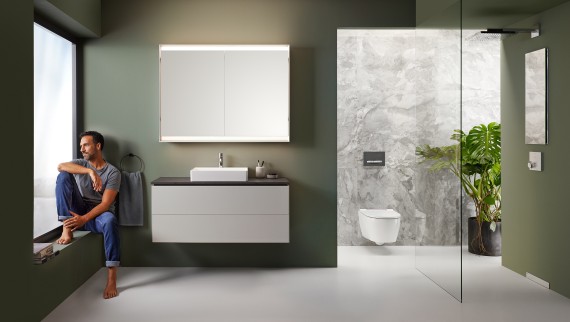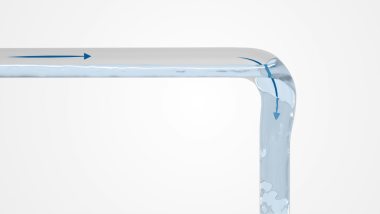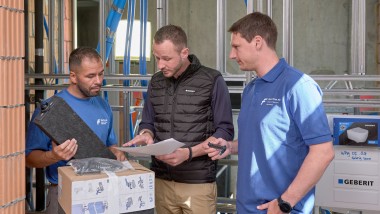Sanitary room planning Even better bathroom planning - with Geberit
Good bathroom planning is essential

In an average lifetime, we spend around 850 days in the bathroom, which equates to more than 2 years of our lives. We shower around 30,000 times and spend over 300 days on the toilet. With figures like these, the bathroom is clearly much more important than we might think.
To ensure that a bathroom meets individual needs and becomes an enjoyable place to relax, good bathroom planning that aligns with the users’ personal requirements is crucial.
This is where Geberit supports professionals with planning the perfect bathroom in line with their customers’ expectations and bringing their projects to life. A successful project hinges on effective sanitary room planning in agreement with the end customer.
Partnership Accompanied planning of sanitary facilities
With Geberit, you can always count on an experienced partner with extensive expertise.
Benefit from our wide-ranging support in the form of product solutions, customer training, specialist seminars and forums, and even a direct local contact.
Optimum planning of sanitary rooms Bathroom organisation tips
- Well thought-out bathroom planning starts as soon as you enter the room. Pay close attention to the line of vision.
- The bathroom vanity is generally positioned in the centre of the bathroom. It should be easily accessible and located near the entrance area.
- To ensure a feeling of privacy, on the other hand, the WC should not be immediately visible from the entrance. This bathroom element is ideally placed behind a (half-height) prewall or in a niche.
- Showers tend to be more popular with customers than bathtubs. With this in mind, you should factor in more space for this at the planning stage.
- The view from the bathtub should contribute to a relaxing overall experience. In this respect, it is preferable to have your customers facing a window rather than a toilet or radiator.
- Having a washbasin near the door is practical if you just want to wash your hands or check your hair quickly.
- Another factor to consider is that rooms with a vanity mirror in the entrance area appear larger and more open.
Room layout in the bathroom Take note of movement and circulation areas
It is essential to observe certain minimum distances and dimensions in any good bathroom design to ensure maximum comfort. This is the only way to ensure that bathroom elements such as the bathroom vanity or WC can be used comfortably. In addition to the space for the sanitary appliances in a bathroom, sufficient movement and circulation areas should always be factored in.
Movement area: A minimum unobstructed floor area must be planned in front of each bathroom element. Movement areas may only overlap if simultaneous use of the bathroom elements is not to be expected. Locally applicable standards must also be observed for the recommended minimum dimensions.
Circulation area: In order to allow unrestricted access when bathroom elements are in use at the same time, a circulation area must be planned in addition to the movement area.
Digital planning tools for professionals

Many useful planning tools are also available for sanitary engineers, plumbers and architects:
Installation systems Bathroom design fundamentals
Installation systems are now a universally accepted standard and form the basis for the design and equipment of bathrooms and sanitary rooms. They consist of a framework structure and the associated installation elements, supplemented by supply and discharge pipes. Installation systems can be divided into three areas:
1. Prewall installation: This installation system is installed in front of a partition wall. The installation elements are integrated into the prewall and supply and drainage pipes are laid. Prewalls can be built in a solid or lightweight construction. In terms of height, they can be part-height, room-height or a combination of the two. The ducts for cross-floor pipes can also be integrated as a prewall.
Suitable systems include: Geberit Duofix
2. Inwall installation: This is where the installation level with installation elements and pipelines is located within the partition wall separating the room. Inwall installations are predominantly constructed using lightweight construction methods due to the space requirements.
Suitable installation systems include: Geberit Duofix
3. Freestanding installation walls: These are primarily used for interior design in spacious bathrooms. They either stand independently in the room as an island or else are connected to a wall on one side. In the case of freestanding islands, the supply and discharge pipes are routed through the floor or into the floor below.
Do you need to know more?
We look forward to hearing from you.






